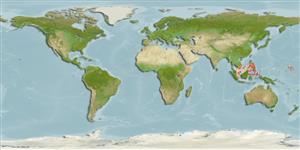Common names from other countries
>
Ovalentaria/misc (Various families in series Ovalentaria) >
Pomacentridae (Damselfishes) > Pomacentrinae
Etymology: Amphiprion: Greek, amphi = on both sides + Greek, prion, -onos = saw (Ref. 45335).
More on authors: Schultz & Welander.
Environment: milieu / climate zone / depth range / distribution range
Ökologie
seewasser riff-verbunden; standorttreu; tiefenbereich 3 - 40 m (Ref. 7247). Tropical; 25°C - ?; 15°N - 0°N
Western Pacific: Marshall Islands. Reported from New Caledonia (Ref. 9070).
Length at first maturity / Size / Gewicht / Alter
Maturity: Lm 7.5, range 7 - 8 cm
Max length : 12.0 cm TL Männchen/unbestimmt; (Ref. 9710)
Rückenflossenstacheln (insgesamt) : 10 - 11; Rückenflossenweichstrahlen (insgesamt) : 15 - 17; Afterflossenstacheln: 2; Afterflossenweichstrahlen: 13 - 14. Black or orange with two vertical black-edged white bands, one behind the eye and one above the after. Black and orange color morphs believed to be dependent on which species of sea anemone the fish is associated with.
Life cycle and mating behavior
Maturities | Fortpflanzung | Spawnings | Egg(s) | Fecundities | Larven
Oviparous, distinct pairing during breeding (Ref. 205). Eggs are demersal and adhere to the substrate (Ref. 205). Males guard and aerate the eggs (Ref. 205). Also Ref. 7471.
Allen, G.R., 1991. Damselfishes of the world. Mergus Publishers, Melle, Germany. 271 p. (Ref. 7247)
IUCN Rote Liste Status (Ref. 130435)
CITES (Ref. 128078)
Not Evaluated
Bedrohung für Menschen
Harmless
Nutzung durch Menschen
Fischereien: nicht kommerziell; Aquarium: Kommerziell
Tools
Zusatzinformationen
Download XML
Internet Quellen
Estimates based on models
Preferred temperature (Ref.
115969): 27.7 - 29.1, mean 28.5 (based on 28 cells).
Phylogenetic diversity index (Ref.
82804): PD
50 = 0.5000 [Uniqueness, from 0.5 = low to 2.0 = high].
Bayesian length-weight: a=0.02512 (0.01571 - 0.04016), b=2.96 (2.82 - 3.10), in cm Total Length, based on LWR estimates for this species & (Sub)family-body (Ref.
93245).
Trophic level (Ref.
69278): 2.3 ±0.0 se; based on diet studies.
Widerstandsfähigkeit (Ref.
120179): mittel, Verdopplung der Population dauert 1,4 - 4,4 Jahre. (K=0.3).
Fishing Vulnerability (Ref.
59153): Low to moderate vulnerability (31 of 100).
